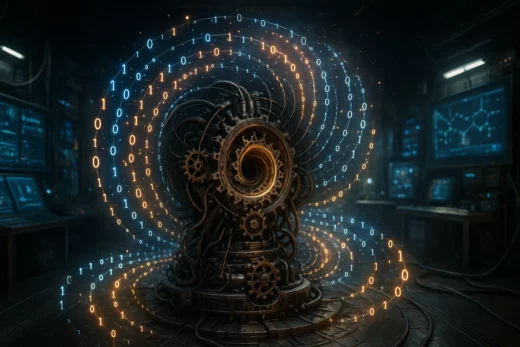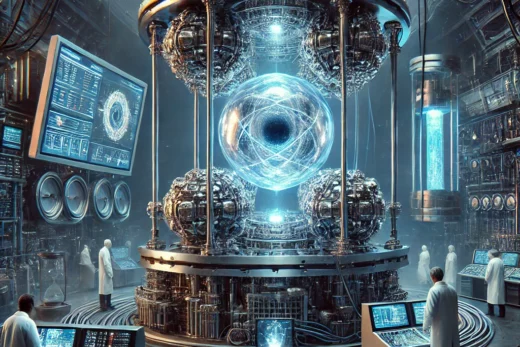If you’re going to bend time to your will, make sure the timeline remembers you.

New School Time Machine
If you’re gonna break causality and tear a hole through the fabric of spacetime, you might as well do it in style. After all, nobody remembers the guy who quietly slipped through the time vortex in a beige box.
Here’s how you bring both theoretical precision and maximum flair to your temporal escapades:
🛠️ How to Build a Time Machine (With Style)
🧠 Step 1: Start with the Science (Sorta)
Let’s keep it just grounded enough not to get vaporized in a quantum backlash.
- Power Source: Planck-scale energy density? Sure. Harness a micro black hole stabilized by a Bose-Einstein condensate loop? Why not.
- Core Drive: A quantum foam tunneler lined with loop quantum gravity stabilizers and encased in a zero-point energy containment field.
- Navigation System: A tachyon-synced chrono-calculator paired with a nonlinear probability compass (a glorified dice roller, but neon).
🧥 Step 2: Design the Aesthetic
You’re not just warping spacetime—you’re making an entrance. Go full retrofuturistic neon noir, cosmic shamanic biomech, or dieselpunk wormhole surfer.
Key Features:
- Exposed Chrono-Coils that arc with controlled lightning every 13.8 seconds.
- A holographic dashboard that updates in languages you haven’t evolved to speak yet.
- Andinkra-coded glyphs glowing across the hull—obviously meaningless to 21st-century observers, but trust me, they’re for navigation.
🔊 Step 3: Engage the Soundtrack
Time travel is 90% attitude.
- Startup Sequence: A deep Vangelis pulse with geiger counter ticks and subharmonic whale song.
- During Jump: Something between Trent Reznor, a Tibetan throat choir, and collapsing stars.
- Emergency Reverse: Rick Astley, but glitchcore.
🐒 Step 4: Bring a Co-Pilot
Ideally:
- A sarcastic AI with emotional baggage
- A quantum-entangled raccoon with a monocle
- Or your own future self who refuses to explain what’s going on
🧳 Step 5: Accessorize for the Multiverse
Don’t leave the timeline without:
- A multiversal passport (hand-stitched from causality violations)
- Temporal insurance (premium rates apply after the 4th paradox)
- A Planck-scale umbrella (for navigating quantum foam storms)

Old School Time Machine
Why Physics Breaks Down at the Planck Scale
Introduction
Across the cosmos, the laws of physics provide an elegant framework for understanding everything from the birth of stars to the expansion of galaxies. Einstein’s theory of general relativity describes the fabric of spacetime, while quantum mechanics governs the behavior of particles at the smallest scales. These two pillars of modern physics have withstood the test of time—until we peer into the most extreme frontier: the Planck scale. At this infinitesimally small realm, our most powerful theories unravel, failing to produce meaningful predictions. But why?
What Is the Planck Scale?
The Planck scale represents the smallest meaningful units of measurement defined by fundamental constants of nature:
- Planck length: ~1.616 × 10⁻³⁵ meters
- Planck time: ~5.391 × 10⁻⁴⁴ seconds
- Planck energy: ~1.22 × 10¹⁹ GeV
These are not just abstract curiosities—they mark thresholds where the quantum effects of gravity become as significant as those of energy and momentum. At this scale, the smooth fabric of spacetime described by relativity begins to look frayed, chaotic, and uncertain.
Where Physics Falls Apart
Both general relativity and quantum mechanics are astonishingly successful in their respective domains, but when pushed to the Planck scale, they produce conflicting and often nonsensical results:
- General relativity, a theory of smooth, continuous spacetime, predicts gravitational forces so intense they collapse into mathematical infinities.
- Quantum field theory, which treats particles as excitations of fields, becomes unreliable when gravitational effects can no longer be ignored.
The paradox deepens when we try to investigate regions smaller than the Planck length. To do so would require immense energy concentrations—so high that they would create microscopic black holes, preventing us from accessing any information from within. It’s like trying to peer closer through a microscope, only for the sample to vanish into a gravitational void.
Why This Breakdown Occurs
This failure isn’t due to nature itself breaking—it’s a sign that our current theories are incomplete. The Planck scale is where our understanding of spacetime as a continuous, smooth fabric collides with the discrete, probabilistic world of quantum mechanics.
This breakdown suggests:
- Space and time might not be continuous at all, but instead quantized at incredibly small scales.
- The constants that define the Planck scale—G (gravitational constant), ħ (reduced Planck constant), and c (speed of light)—aren’t just useful for calculation. Together, they encode a deep limit to how finely we can probe reality.
Ultimately, it points to the need for a quantum theory of gravity—a still-elusive framework that could unify Einstein’s curved spacetime with quantum uncertainty.
Glimpses Beyond: Speculative Frontiers
Though we haven’t yet cracked the code, several theoretical frameworks strive to describe physics at the Planck scale:
- String theory proposes that the fundamental building blocks of reality are tiny vibrating strings rather than point particles.
- Loop quantum gravity suggests spacetime is woven from discrete loops, forming a granular structure at the smallest scales.
- Concepts like quantum foam, extra dimensions, and spacetime discreteness hint at a reality that’s far stranger than our current equations can describe.
However, these ideas remain speculative. Without experimental evidence, the Planck scale remains more of a philosophical edge than a scientific one—a boundary where math outpaces measurement.
How does this theory interact with time travel theories?
Great question—exploring how Planck-scale physics interacts with time travel theories takes us deep into speculative but fascinating territory where mainstream physics meets theoretical frontiers. Here’s a detailed breakdown:
🧠 How Planck-Scale Physics Relates to Time Travel Theories
Time travel—whether to the past or future—depends on our understanding of spacetime geometry, causality, and quantum behavior. The Planck scale is where these very concepts may break down or change entirely, and that opens the door to radical possibilities.
🔹 1. Classical Time Travel and General Relativity
Classical time travel theories often emerge from Einstein’s general relativity, which allows for exotic solutions to the equations of spacetime:
- Closed Timelike Curves (CTCs) – paths in spacetime that loop back to their starting point in time (e.g., Gödel universe, Tipler cylinders, or traversable wormholes).
- Wormholes – hypothetical bridges through spacetime that could connect distant times or locations.
🧠 At the macroscopic level, these are mathematically valid (though highly speculative) solutions—but they’re unstable without quantum corrections.
🔹 2. Where Planck-Scale Physics Disrupts the Picture
Here’s where the Planck scale becomes critical:
- At distances shorter than the Planck length, spacetime becomes unpredictable, possibly discrete or even non-existent in the classical sense.
- Attempts to manipulate spacetime at these levels (e.g., stabilizing wormholes with “exotic matter”) run into quantum gravity limits we don’t yet understand.
🚧 Implication: The very notion of “smooth spacetime” needed for time loops may not survive at the Planck scale.
🔹 3. Quantum Foam and Causal Instability
John Wheeler proposed that at the Planck scale, spacetime becomes a quantum foam—a seething mess of tiny black holes and wormholes popping in and out of existence.
- If wormholes are part of this foam, it’s possible they might briefly allow causal violations.
- However, these fluctuations are too unstable to be navigable by macroscopic objects.
🌀 Time travel at this scale may exist in theory, but not in a usable or controllable form—more like statistical blips in causality.
🔹 4. Chronology Protection Conjecture
Stephen Hawking proposed the Chronology Protection Conjecture, which suggests quantum effects (possibly from the Planck scale) prevent the formation of time machines.
- Quantum fields might diverge near CTCs, destroying them before they form.
- This idea implies that Planck-scale physics may act as a natural firewall to preserve causality.
🔹 5. Quantum Gravity and New Models of Time
Theories trying to unify quantum mechanics and gravity (like string theory or loop quantum gravity) might radically redefine time:
- Loop quantum gravity treats time as emergent from relationships between quantum states.
- String theory implies that time could have multiple dimensions or exist only in certain configurations of higher-dimensional space (e.g., brane-world models).
- Some models even suggest time doesn’t exist at the Planck scale—it’s an emergent property at macroscopic levels.
🚨 This implies time travel as we know it may be a macroscopic illusion, with no consistent meaning at Planckian depths.
🧬 Summary: Planck Scale vs Time Travel
| Concept | Interaction with Planck Scale |
|---|---|
| Classical Time Machines | May not survive quantum-scale instabilities |
| Wormholes | Theoretically possible, but destabilized at quantum scales |
| Quantum Foam | Allows for brief, chaotic causal violations |
| Causality | Likely protected by quantum gravity effects |
| Time Itself | Possibly emergent or ill-defined below the Planck scale |
🔮 Final Thought:
If time travel ever becomes reality, it probably won’t hinge on flux capacitors or conveniently rotating black holes. Instead, it’ll require a radical reimagining of spacetime itself—where “time” behaves less like a ruler and more like a quantum probability fog, fluctuating, contextual, and weirdly personal. Before we can surf temporal currents, we may need to reconstruct the entire concept of time from the Planck level up—where it may not even exist as we know it.
Einstein gave us the equations. Hawking gave us the paradoxes. But you—intrepid chrononaut—you’re here to give us the style. Because if the deepest secrets of the cosmos are buried under a veil of quantum uncertainty, they’re not going to reveal themselves to someone who showed up underprepared and underdressed.
The failure of physics at the Planck scale isn’t a bug in the universe—it’s an open door. A cosmic whisper daring us to go deeper. It invites us to question everything: what space is, what time is, even what it means to exist. This isn’t just about unifying quantum mechanics with gravity—it’s about peeling back the layers of reality itself.
What lies beyond the Planck threshold probably won’t resemble anything we know. It could shatter our assumptions about dimensions, particles, causality, and even consciousness. This isn’t the next page in the physics textbook. It’s the moment we realize the textbook is written in a language we haven’t learned yet.
To cross that boundary, we’ll need more than math. We’ll need a new philosophy. A new lens on existence. And maybe—just maybe—a damn good outfit.

Time Suit Patent Pending



